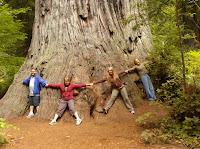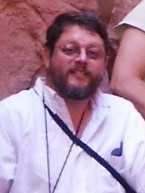
Our plan WAS to go to New Orleans for the Christmas – New Year holiday week. We reserved our plane tickets way back in September, using our remaining frequent flier miles that we earned when we were flying around the world fairly regularly. We reserved our hotel rooms at the Frenchman in the French Quarter back in October. We had a great itinerary all worked out:
Dec 25 – fly from Las Vegas to New Orleans in the afternoon.
Dec 26 – Explore the French Quarter, including the Cathedral, and then go over to Algiers Point to see Mardi Gras World.
Dec 27 – Explore the Warehouse District and check out a bunch of the cool museums there, like the Confederate Museum.
Dec 28 – Explore the Garden District in the morning (we had lunch reservations at Commander’s Palace) and then the Museum of Art in the afternoon (they had a traveling exhibit of the Impressionists.)
Dec 29 – We had a rental car reserved so we could drive out to see several old plantations and their mansions, including the plantation where the Uncle Remus stories were documented.
Dec 30 – Finish up the French Quarter, including the neat old above-ground cemetery and the Historic Voodoo Museum.
Dec 31 – Do some shopping in the French Quarter in the morning and fly back to Las Vegas in the evening, and spend New Years Eve in Las Vegas.
So, we got all packed up and ready to go on the 24th. On Christmas morning, after we chatted with Colin Jr. in Bulgaria, had breakfast, opened presents, and cleaned up a bit, we loaded up the car and headed toward the airport in Las Vegas to catch our plane to New Orleans. As we were backing out of the driveway I noticed that the battery and brake lights came on in the dashboard of the car – that was troubling – but I knew that we’d recently replaced the entire brake system (front and back) and that the battery was pretty new (maybe one year old, at most) and the car seemed to be running just fine, so we headed off anyway. There was a little voice inside my head telling me to switch over to the 4-Runner, but it wasn’t topped off with gasoline, so I decided to head off anyway. As we drove down the freeway the car seemed to handle OK, but I kept thinking through who I could call on my cell phone if we were actually to break down. Just as we passed the last exit to Mesquite several other lights came on my dashboard and I decided that we were in trouble. The next exit from the freeway was about ten miles away and I was hoping that we’d make it so I could drive back at least to Mesquite, but we didn’t. Just a mile or two short of the exit, the car completely quit and I coasted to a stop off the shoulder of the freeway, right between several hills where we couldn’t get any cell phone service. I got out and looked under the hood of the car, hoping to find a loose battery cable or something, but didn’t find anything out of place. So we got back in the car and Leslie offered a little prayer. Then I was able to start the car and we made it to the next freeway exit; I drove under the freeway and headed back towards Mesquite, but the car didn’t make it onto the freeway – we were dead dead dead – I looked under the hood again, but there was still nothing obviously wrong. Fortunately we had cellphone service at this second location and I was able to phone a friend from work who lives in Littlefield, Arizona, just twenty miles or so back up the freeway. He offered to come get us and we accepted. So we played with our new Christmas game, Catchphrase, and amused ourselves until he arrived. He brought a large pickup truck, with room for all of us to ride inside, and a flatbed trailer big enough to carry our dead car. Then he drove us back home to St. George, where I dropped off Les and the girls, and then we took the car to the shop to leave it for the next business day (that day still being Christmas.) I called American Airlines and they told me that all the flights to New Orleans were booked solid for the next few days, so then we called and canceled our hotel, rental car, and restaurant reservations and then we unpacked our bags. Sigh. Maybe we can make New Orleans at Spring Break.
Dec 25 – fly from Las Vegas to New Orleans in the afternoon.
Dec 26 – Explore the French Quarter, including the Cathedral, and then go over to Algiers Point to see Mardi Gras World.
Dec 27 – Explore the Warehouse District and check out a bunch of the cool museums there, like the Confederate Museum.
Dec 28 – Explore the Garden District in the morning (we had lunch reservations at Commander’s Palace) and then the Museum of Art in the afternoon (they had a traveling exhibit of the Impressionists.)
Dec 29 – We had a rental car reserved so we could drive out to see several old plantations and their mansions, including the plantation where the Uncle Remus stories were documented.
Dec 30 – Finish up the French Quarter, including the neat old above-ground cemetery and the Historic Voodoo Museum.
Dec 31 – Do some shopping in the French Quarter in the morning and fly back to Las Vegas in the evening, and spend New Years Eve in Las Vegas.
So, we got all packed up and ready to go on the 24th. On Christmas morning, after we chatted with Colin Jr. in Bulgaria, had breakfast, opened presents, and cleaned up a bit, we loaded up the car and headed toward the airport in Las Vegas to catch our plane to New Orleans. As we were backing out of the driveway I noticed that the battery and brake lights came on in the dashboard of the car – that was troubling – but I knew that we’d recently replaced the entire brake system (front and back) and that the battery was pretty new (maybe one year old, at most) and the car seemed to be running just fine, so we headed off anyway. There was a little voice inside my head telling me to switch over to the 4-Runner, but it wasn’t topped off with gasoline, so I decided to head off anyway. As we drove down the freeway the car seemed to handle OK, but I kept thinking through who I could call on my cell phone if we were actually to break down. Just as we passed the last exit to Mesquite several other lights came on my dashboard and I decided that we were in trouble. The next exit from the freeway was about ten miles away and I was hoping that we’d make it so I could drive back at least to Mesquite, but we didn’t. Just a mile or two short of the exit, the car completely quit and I coasted to a stop off the shoulder of the freeway, right between several hills where we couldn’t get any cell phone service. I got out and looked under the hood of the car, hoping to find a loose battery cable or something, but didn’t find anything out of place. So we got back in the car and Leslie offered a little prayer. Then I was able to start the car and we made it to the next freeway exit; I drove under the freeway and headed back towards Mesquite, but the car didn’t make it onto the freeway – we were dead dead dead – I looked under the hood again, but there was still nothing obviously wrong. Fortunately we had cellphone service at this second location and I was able to phone a friend from work who lives in Littlefield, Arizona, just twenty miles or so back up the freeway. He offered to come get us and we accepted. So we played with our new Christmas game, Catchphrase, and amused ourselves until he arrived. He brought a large pickup truck, with room for all of us to ride inside, and a flatbed trailer big enough to carry our dead car. Then he drove us back home to St. George, where I dropped off Les and the girls, and then we took the car to the shop to leave it for the next business day (that day still being Christmas.) I called American Airlines and they told me that all the flights to New Orleans were booked solid for the next few days, so then we called and canceled our hotel, rental car, and restaurant reservations and then we unpacked our bags. Sigh. Maybe we can make New Orleans at Spring Break.


















